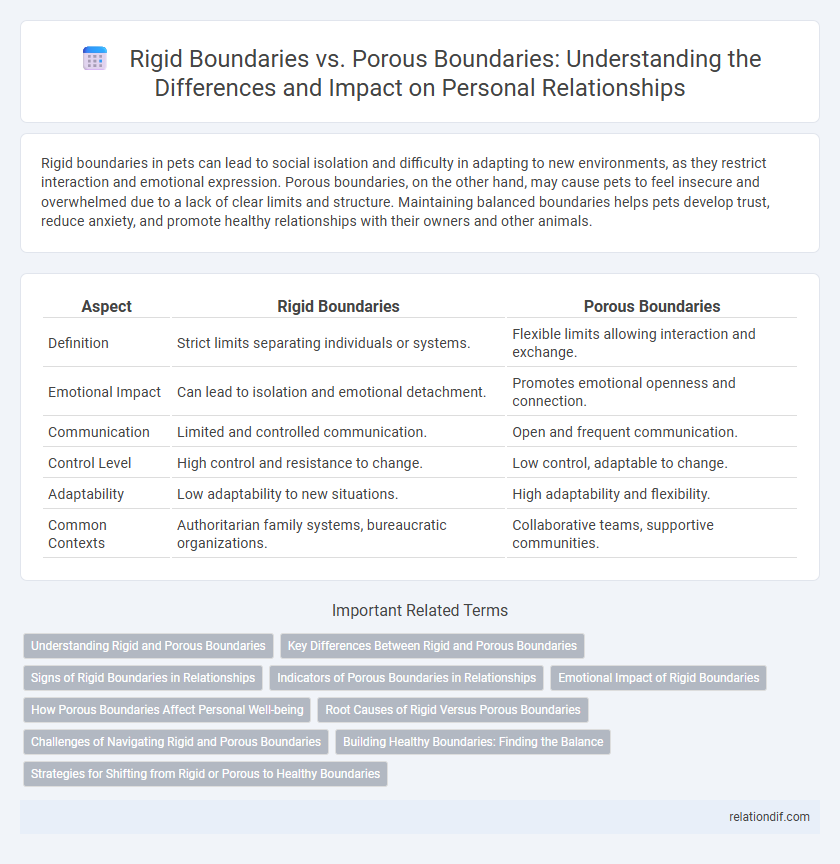Rigid boundaries in pets can lead to social isolation and difficulty in adapting to new environments, as they restrict interaction and emotional expression. Porous boundaries, on the other hand, may cause pets to feel insecure and overwhelmed due to a lack of clear limits and structure. Maintaining balanced boundaries helps pets develop trust, reduce anxiety, and promote healthy relationships with their owners and other animals.
Table of Comparison
| Aspect | Rigid Boundaries | Porous Boundaries |
|---|---|---|
| Definition | Strict limits separating individuals or systems. | Flexible limits allowing interaction and exchange. |
| Emotional Impact | Can lead to isolation and emotional detachment. | Promotes emotional openness and connection. |
| Communication | Limited and controlled communication. | Open and frequent communication. |
| Control Level | High control and resistance to change. | Low control, adaptable to change. |
| Adaptability | Low adaptability to new situations. | High adaptability and flexibility. |
| Common Contexts | Authoritarian family systems, bureaucratic organizations. | Collaborative teams, supportive communities. |
Understanding Rigid and Porous Boundaries
Rigid boundaries create clear separations between individuals or groups, limiting emotional exchange and often leading to isolation or misunderstandings. Porous boundaries allow greater fluidity in interactions, fostering openness and adaptability but can risk emotional overwhelm or loss of personal limits. Recognizing the balance between these boundary types is essential for healthy relationships and effective communication.
Key Differences Between Rigid and Porous Boundaries
Rigid boundaries limit emotional expression and reduce interpersonal connection, often leading to isolation and misunderstandings. Porous boundaries, in contrast, allow for emotional fluidity and open communication, but can result in vulnerability and boundary violations if not managed carefully. The key difference lies in the balance between protection and openness, affecting personal well-being and relational dynamics.
Signs of Rigid Boundaries in Relationships
Signs of rigid boundaries in relationships include difficulty in expressing emotions, avoiding vulnerability, and maintaining excessive distance from others. Individuals with rigid boundaries often struggle with trust and may resist intimacy, leading to isolation and communication breakdowns. This inflexibility can hinder relationship growth and create barriers to genuine connection.
Indicators of Porous Boundaries in Relationships
Indicators of porous boundaries in relationships include frequent feelings of emotional overwhelm and difficulty distinguishing one's own needs from others'. People with porous boundaries often experience excessive guilt, struggle to say no, and tend to overextend themselves to please others. These signs reveal a blurred line between personal limits and external influences, leading to potential emotional exhaustion and loss of autonomy.
Emotional Impact of Rigid Boundaries
Rigid boundaries often lead to emotional isolation, creating a barrier that limits vulnerability and authentic connection with others. These inflexible limits can heighten feelings of loneliness, anxiety, and emotional suppression, as individuals struggle to express needs or receive support. The lack of emotional permeability in rigid boundaries hinders relational intimacy and may contribute to unresolved internal conflicts.
How Porous Boundaries Affect Personal Well-being
Porous boundaries often lead to emotional exhaustion as individuals struggle to differentiate their own needs from others', increasing stress and reducing personal well-being. Constant exposure to external demands without clear limits can result in anxiety, decreased self-esteem, and difficulty maintaining healthy relationships. Establishing a balance by recognizing and respecting personal limits helps protect mental health and fosters resilience.
Root Causes of Rigid Versus Porous Boundaries
Rigid boundaries often stem from fear of vulnerability or past trauma, leading individuals to isolate themselves emotionally and physically. Porous boundaries can arise from a lack of self-awareness or learned behavior in environments where personal limits were not respected or modeled. Understanding these root causes is essential for developing healthier, more balanced interpersonal relationships.
Challenges of Navigating Rigid and Porous Boundaries
Rigid boundaries often create challenges such as limited communication and reduced emotional intimacy, leading to isolation and conflict in relationships. Porous boundaries may result in blurred roles and lack of personal space, causing stress and emotional exhaustion. Balancing these boundaries requires careful negotiation to maintain healthy interaction without compromising individual autonomy.
Building Healthy Boundaries: Finding the Balance
Rigid boundaries create isolation by excessively restricting emotional and physical closeness, while porous boundaries lead to vulnerability through lack of clear limits. Building healthy boundaries requires balancing self-protection with openness to foster meaningful connections and maintain personal well-being. Effective boundary-setting involves clear communication and consistent enforcement to ensure respect without alienation.
Strategies for Shifting from Rigid or Porous to Healthy Boundaries
Establishing healthy boundaries involves recognizing and adjusting extremes in rigidity or porosity by setting clear limits on personal time, emotions, and responsibilities. Effective strategies include consistent self-reflection, assertive communication, and gradual exposure to flexible interactions that respect both self-needs and others' autonomy. Incorporating mindfulness techniques and seeking professional guidance can further reinforce balanced boundary-setting practices.
rigid boundaries vs porous boundaries Infographic

 relationdif.com
relationdif.com